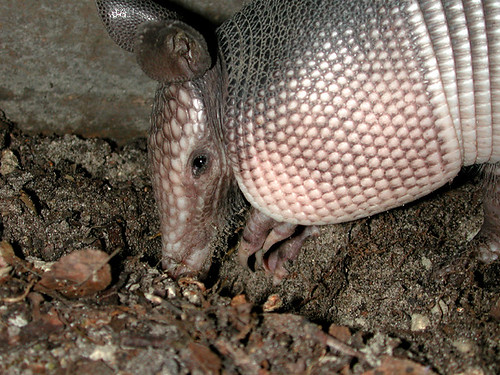
From back in 2003, a litter of armadillo were born under my house.
Armadillos are unfortunate in that are among the few known species that can contract leprosy. I want to stress the word CAN here. No, not all armadillos are carriers of leprosy as far too many people believe. But they can get it just as humans, mangabey monkeys, rabbits and mice can. It is too often misunderstood that all armadillos have the disease, they do not.
Prior to the arrival of Europeans in the late 15th century, leprosy was unknown in the New World. Given that armadillos are native to the New World, at some point they must have acquired the disease from humans. This is a scientific fact. So it is a matter of susceptibility NOT that one species alone is the main carrier spreading the disease.

In order for a human to get leprosy from an armadillo it has to be infected first of all. Secondly you'd have to eat and/or heavily handle it. Armadillo to human spread cases are concentrated in Louisiana and Texas, where some people hunt, skin and eat armadillos.
Only about 150 to 250 people in the United States each year even get leprosy and not all of those cases were caused by armadillos. So, just be very careful when handling an armadillo dead or alive and avoid eating it and you're very unlikely to ever get it. Approximately 95% of people are naturally immune to the disease anyway and sufferers are no longer infectious after as little as two weeks of treatment if the disease is recognized and treated early on.



2 comments:
I saw this awhile back, but had to re-read because I wanted to double re-assure myself what you had stated here. My friend's dog shook a poor armadillo to death and he saved it and gave it to me. I was examining it (with proper gear) and was admiring it's beauty and I almost don't have the heart to let it decompose--I almost want to mummify it, if thats even possible. I don't know what their armor would do in borax. I also don't know if it may or may not have had leprosy, and if I should even try to mummify, or process it at all. It's curled in a perfect crescent shape and everything is intact with the exception of a pierced belly and right side.
I'm not worried, just cautious.
Hi Crystal!
No really sure what your question it. I have no dry preserved any armadillo parts before. Only found them already mummified. But I know they can be preserved and used as an art/craft supply to make something like bowls or purses, etc. I'd say best place to look would be at taxidermy.net
Good luck!
jana
Post a Comment